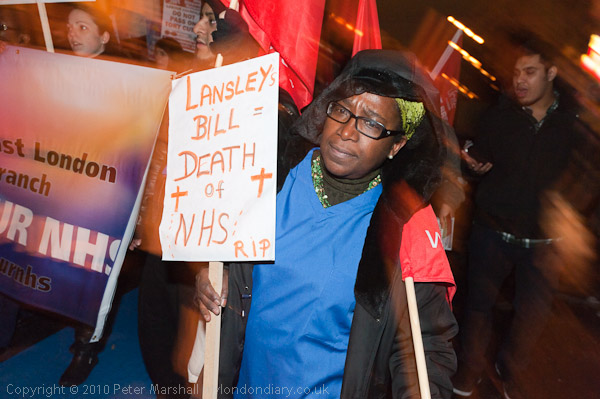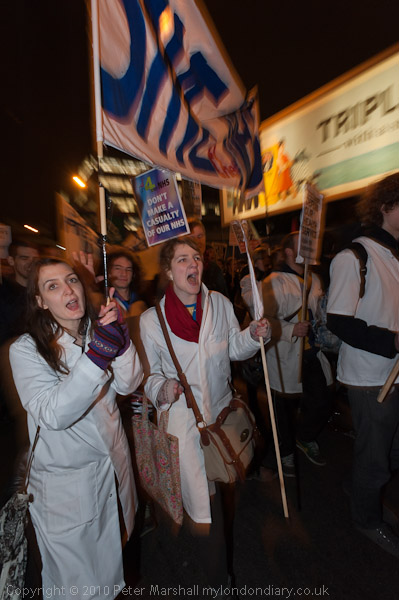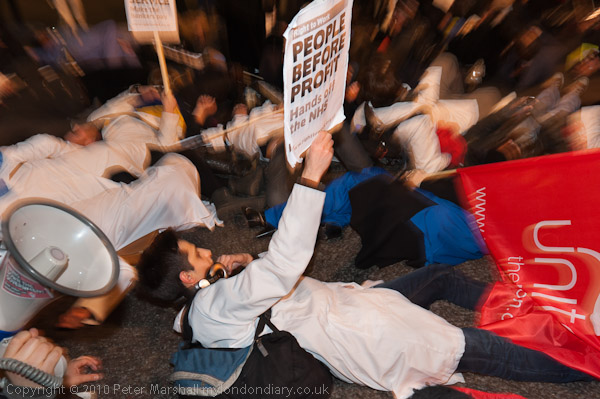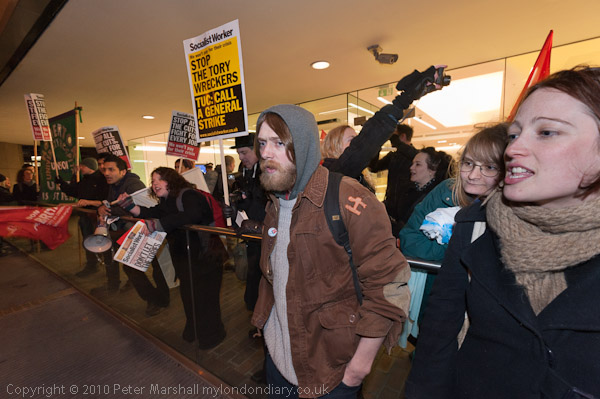
The marchers gathered for a rally outside the Royal London Hospital at Whitechapel as it was getting dark, and as they listened to the speeches I was able to take pictures both with and without flash. Usually I work with two cameras, the Nikon D700 and the D300, but only take one SB800 flash – I just find it too difficult to handle two cameras both with flash mounted on them. Working with two on straps around my neck is tricky enough, and I sometimes find I have them tied in knots and have to stop and untangle them before I can carry on.
Now we can work at high ISO and get good results, the main advantages of flash in this kind of situation is really in colour. Street lighting is usually a pretty discontinuous spectrum, particularly where orange sodium lighting is still in use, and adding a little daylight with the flash always makes people look healthier.
At first I mainly worked with the flash on the D300 as I wanted to use it with the longer focal lengths of the 18-105 zoom (27-155eq) where camera shake would have been a problem without it. With the wideangle 16-35mm on the D700 you can certainly work at slower speeds and keep static subjects sharp (though you can’t rely on people to stay still.) I had the vibration reduction switched on, though I’ve still to be convinced it makes any difference, but it doesn’t do any harm.
I started working with the flash in balanced flash mode (TTL/BL) which balances the flash with the ambient light, using what I now regard as the moderate ISO 1250, and setting a minimum shutter speed of 1/30s. Later as it got darker I switched to standard TTL flash, but kept the shutter speed at 1/30s while remembering to set aperture priority so I could work at f5.6. With the wide angle there is seldom any need to stop down more than this, though in P mode Nikon selects f8 at ISO 1250. The extra stop at f5.6 does give better results in decent street lighting, though in some of the darker areas the march later went through I should have set a higher ISO but forgot.

1/30s is an interesting speed with people marching and me walking backwards when taking pictures. Without the flash there would be at least a slight blur, but the flash provides a sharp image of people near to the camera. The effect isn’t exactly predictable – and in the top picture where I was very close to the woman with the placard (the lens was at 24mm) I was actually stumbling slightly when I took the picture, which gives the exaggerated blur in the background.

In this picture I was moving the zoom ring and again the flash gives a sharp image which predominates for the close objects. It wasn’t done deliberately, just part of working in a hurry, but I rather like the effect it gives.
Working with flash does often involve quite a lot of work in Lightroom.

Image ‘as taken’ – from embedded preview

After processing in Lightroom
The line of people on the balcony outside the RBS in Aldgate are at rather different distance from the flash. I was using the lens at 16mm (1/30 f6.3 ISO 1250) and with the flash diffuser in place the SB800 gives fairly even coverage, which was a slight pity as I could have done with less on the woman at the right of frame. Often I try and angle the flash a bit away from close subject matter on one side like this, and I think I probably did on this occasion.
There is an obvious difference in the colour temperature and you can see that all the figures close to the flash have been darkened while those further from it – and lit mainly by the street lighting – have been made lighter. The processed image is a much better representation of how it actually looked.
You can read more about the rally and march and what the plans will mean for the NHS in Day X Defend the NHS on My London Diary where there is a large set of pictures, mainly taken with flash.